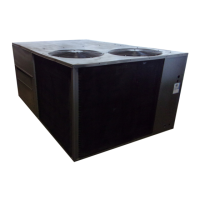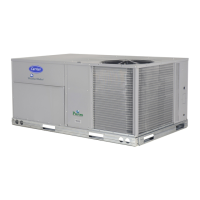46
If field-installed accessory CO
2
sensors are connected to
the PremierLink™ control, a PID-controlled demand ventila-
tion strategy will begin to operate. As the CO
2
level in the zone
increases above the CO
2
set point, the minimum position of the
damper will be increased proportionally. As the CO
2
level
decreases because of the increase in fresh air, the outdoor-air
damper will be proportionally closed.
HEATING, UNIT WITH ECONOMI$ER2, PREMIERLINK
CONTROL AND A ROOM SENSOR — Every 40 seconds
the controller will calculate the required heat stages (maximum
of 3) to maintain supply-air temperature (SAT) if the following
qualifying conditions are met:
• Indoor fan has been on for at least 30 seconds.
• COOL mode is not active.
• OCCUPIED, TEMP. COMPENSATED START or
HEAT mode is active.
• SAT reading is available.
• Fire shutdown mode is not active.
If all of the above conditions are met, the number of heat
stages is calculated; otherwise the required number of heat
stages will be set to 0.
If the PremierLink controller determines that heat stages are
required, the economizer damper will be moved to minimum
position if occupied and closed if unoccupied.
Staging should be as follows:
If Heating PID STAGES=2
• HEAT STAGES=1 (50% capacity) will energize HS1
• HEAT STAGES=2 (100% capacity) will energize HS2
If Heating PID STAGES=3 and AUXOUT = HS3
• HEAT STAGES=1 (33% capacity) will energize HS1
• HEAT STAGES=2 (66% capacity) will energize HS2
• HEAT STAGES=3 (100% capacity) will energize HS3
UNITS WITH HUMIDI-MIZER™ ADAPTIVE DEHU-
MIDIFICATION SYSTEM
Normal Design Cooling Operation
— When the rooftop op-
erates under the normal sequence of operation, the compressors
will cycle to maintain indoor conditions. See Fig. 49.
The Humidi-MiZer adaptive dehumidification system in-
cludes a factory-installed Motormaster® low ambient control
to keep the head and suction pressure high, allowing normal
design cooling mode operation down to 0° F.
Subcooling Mode
— When subcooling mode is initiated, this
will energize (close) the liquid line solenoid valve (LLSV)
forcing the hot liquid refrigerant to enter into the subcooling
coil (see Fig. 50).
As the hot liquid refrigerant passes through the subcooling/
reheat dehumidification coil, it is exposed to the cold supply
airflow coming through the evaporator coil. The liquid is fur-
ther subcooled to a temperature approaching the evaporator
leaving-air temperature. The liquid then enters a thermostatic
expansion valve (TXV) where the liquid drops to a lower
pressure. The TXV does not have a pressure drop great enough
to change the liquid to a 2-phase fluid, so the liquid then enters
the Acutrol™ device at the evaporator coil.
The liquid enters the evaporator coil at a temperature lower
than in standard cooling operation. This lower temperature in-
creases the latent capacity of the rooftop unit. The refrigerant
passes through the evaporator and is turned into a vapor. The
air passing over the evaporator coil will become colder than
during normal operation. However, as this same air passes over
the subcooling coil, it will be slightly warmed, partially reheat-
ing the air.
Subcooling mode operates only when the outside-air tem-
perature is warmer than 40 F. A factory-installed temperature
switch located in the condenser section will lock out subcool-
ing mode when the outside temperature is cooler than 40 F.
The scroll compressors are equipped with crankcase heaters
to provide protection for the compressors due to the additional
refrigerant charge required by the subcooling/reheat coil.
When in subcooling mode, there is a slight decrease in sys-
tem total gross capacity (5% less), a lower gross sensible
capacity (20% less), and a greatly increased latent capacity (up
to 40% more).
Hot Gas Reheat Mode
— When the humidity levels in the
space require humidity control, a hot gas solenoid valve (spe-
cific to hot gas reheat mode only) will open to bypass a portion
of hot gas refrigerant around the condenser coil (see Fig. 51).
This hot gas will mix with liquid refrigerant leaving the con-
denser coil and flow to the subcooling/reheat dehumidification
coil. Now the conditioned air coming off the evaporator will be
cooled and dehumidified, but will be warmed to neutral condi-
tions (72 F to 75 F) by the subcooling/reheat dehumidification
coil.
NOTE: The 50HJ008-014 rooftop units can operate one circuit
in subcooling mode and one circuit in hot gas reheat mode or
both circuits in hot gas reheat mode, or both in normal design
cooling mode.
Fig. 49 — Humidi-MiZer Normal Design
Cooling Operation
Fig. 50 — Humidi-MiZer Subcooling Mode
Operation

